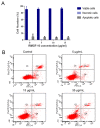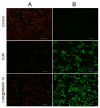Preparation, Characterization, and In Vitro Release of Curcumin-Loaded IRMOF-10 Nanoparticles and Investigation of Their Pro-Apoptotic Effects on Human Hepatoma HepG2 Cells
- PMID: 35745062
- PMCID: PMC9228752
- DOI: 10.3390/molecules27123940
Preparation, Characterization, and In Vitro Release of Curcumin-Loaded IRMOF-10 Nanoparticles and Investigation of Their Pro-Apoptotic Effects on Human Hepatoma HepG2 Cells
Abstract
Curcumin (CUR) has a bright future in the treatment of cancer as a natural active ingredient with great potential. However, curcumin has a low solubility, which limits its clinical application. In this study, IRMOF-10 was created by the direct addition of triethylamine, CUR was loaded into IRMOF-10 using the solvent adsorption method, and the two were characterized using a scanning electron microscope (SEM), X-ray diffraction (XRD), dynamic light scattering (DLS), Fourier transform infrared spectroscopy (FTIR), thermogravimetric analysis (TG) methods, and Brunauer-Emmett-Teller (BET) analysis. We also used the MTT method, 4',6-diamidino-2-phenylindole (DAPI) staining, the annexin V/PI method, cellular uptake, reactive oxygen species (ROS), and the mitochondrial membrane potential (MMP) to perform a safety analysis and anticancer activity study of IRMOF-10 and CUR@IRMOF-10 on HepG2 cells. Our results showed that CUR@IRMOF-10 had a CUR load of 63.96%, with an obvious slow-release phenomenon. The CUR levels released under different conditions at 60 h were 33.58% (pH 7.4) and 31.86% (pH 5.5). Cell experiments proved that IRMOF-10 was biologically safe and could promote curcumin entering the nucleus, causing a series of reactions, such as an increase in reactive oxygen species and a decrease in the mitochondrial membrane potential, thereby leading to cell apoptosis. In summary, IRMOF-10 is an excellent drug carrier and CUR@IRMOF-10 is an effective anti-liver cancer sustained-release preparation.
Keywords: HepG2 cells; IRMOF-10; MOFs; curcumin.
Conflict of interest statement
The authors declare no conflict of interest.
Figures












Similar articles
-
Curcumin-loaded galactosylated BSA nanoparticles as targeted drug delivery carriers inhibit hepatocellular carcinoma cell proliferation and migration.Int J Nanomedicine. 2018 Dec 6;13:8309-8323. doi: 10.2147/IJN.S184379. eCollection 2018. Int J Nanomedicine. 2018. PMID: 30584302 Free PMC article.
-
Cisplatin and curcumin co-loaded nano-liposomes for the treatment of hepatocellular carcinoma.Int J Pharm. 2018 Jul 10;545(1-2):261-273. doi: 10.1016/j.ijpharm.2018.05.007. Epub 2018 May 3. Int J Pharm. 2018. PMID: 29730175
-
The role of the vascular endothelial growth factor/vascular endothelial growth factor receptors axis mediated angiogenesis in curcumin-loaded nanostructured lipid carriers induced human HepG2 cells apoptosis.J Cancer Res Ther. 2015 Jul-Sep;11(3):597-605. doi: 10.4103/0973-1482.159086. J Cancer Res Ther. 2015. PMID: 26458588
-
Preparation and in-vitro/in-vivo evaluation of curcumin nanosuspension with solubility enhancement.J Pharm Pharmacol. 2016 Aug;68(8):980-8. doi: 10.1111/jphp.12575. Epub 2016 Jun 10. J Pharm Pharmacol. 2016. PMID: 27283220
-
Investigation of Metal-Organic Framework-5 (MOF-5) as an Antitumor Drug Oridonin Sustained Release Carrier.Molecules. 2019 Sep 16;24(18):3369. doi: 10.3390/molecules24183369. Molecules. 2019. PMID: 31527488 Free PMC article.
Cited by
-
Prominent Naturally Derived Oxidative-Stress-Targeting Drugs and Their Applications in Cancer Treatment.Antioxidants (Basel). 2025 Jan 3;14(1):49. doi: 10.3390/antiox14010049. Antioxidants (Basel). 2025. PMID: 39857383 Free PMC article. Review.
-
Isoreticular Metal-Organic Framework-3 (IRMOF-3): From Experimental Preparation, Functionalized Modification to Practical Applications.Polymers (Basel). 2024 Jul 26;16(15):2134. doi: 10.3390/polym16152134. Polymers (Basel). 2024. PMID: 39125160 Free PMC article. Review.
-
Recent Advances in Sensing Materials Targeting Clinical Volatile Organic Compound (VOC) Biomarkers: A Review.Biosensors (Basel). 2023 Jan 9;13(1):114. doi: 10.3390/bios13010114. Biosensors (Basel). 2023. PMID: 36671949 Free PMC article. Review.
-
Metal-organic framework-mediated antioxidant enzyme delivery in disease treatment.Redox Biol. 2025 Sep;85:103778. doi: 10.1016/j.redox.2025.103778. Epub 2025 Jul 18. Redox Biol. 2025. PMID: 40714403 Free PMC article. Review.
-
Thermal Chemisorption and Reduction of Carbon Dioxide on UiO-66(Zr) and MIL-100(Fe).Nanomaterials (Basel). 2025 Mar 22;15(7):479. doi: 10.3390/nano15070479. Nanomaterials (Basel). 2025. PMID: 40214525 Free PMC article.
References
-
- Cai M., Qin L., Pang L., Ma B., Bai J., Liu J. Amino-functionalized Zn metal organic frameworks as antitumor drug curcumin carriers. New J. Chem. 2020;44:17693–17704. doi: 10.1039/D0NJ03680C. - DOI
MeSH terms
Substances
Grants and funding
LinkOut - more resources
Full Text Sources
Medical
Research Materials
Miscellaneous

